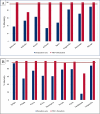Pyrethroid-resistant malaria vector Anopheles gambiae restored susceptibility after pre-exposure to piperonyl-butoxide: results from country-wide insecticide resistance monitoring in Tanzania, 2023
- PMID: 39709444
- PMCID: PMC11663351
- DOI: 10.1186/s12936-024-05211-7
Pyrethroid-resistant malaria vector Anopheles gambiae restored susceptibility after pre-exposure to piperonyl-butoxide: results from country-wide insecticide resistance monitoring in Tanzania, 2023
Abstract
Background: Effective vector control interventions, notably insecticide-treated nets (ITNs) and indoor residual spraying (IRS) are indispensable for malaria control in Tanzania and elsewhere. However, the emergence of widespread insecticide resistance threatens the efficacy of these interventions. Monitoring of insecticide resistance is, therefore, critical for the selection and assessment of the programmatic impact of insecticide-based interventions.
Methods: The study was conducted country-wide across 22 sentinel districts of Tanzania between May and July 2023 using standard World Health Organization susceptibility test with 1×, 5×, and 10× of deltamethrin, permethrin, and alpha-cypermethrin and discriminating concentrations of 0.25% pirimiphos-methyl. Synergist assays were conducted to explore the underlying mechanisms of the observed phenotypic pyrethroid-resistant mosquitoes. Three- to five-day-old wild adult females in the first filiar generation of Anopheles gambiae sensu lato (s.l.) were used for the susceptibility bioassays.
Results: Anopheles gambiae s.l. were resistant to all pyrethroids at the discriminating dose in most sentinel districts except in Rorya, which remains fully susceptible, and Ushetu, which remains susceptible to deltamethrin but not permethrin. In 5 sites (Bukombe, Ukerewe, Kilwa, Kibondo, and Kakonko), the An. gambiae s.l. species exhibited strong resistance to pyrethroids surviving the 10 X concentrations (mortality rate < 98%). However, they remained fully susceptible to pirimiphos-methyl in almost all the sites except in Kibondo and Shinyanga. Likewise, there was full restoration to susceptibility to pyrethroid following pre-exposure of An. gambiae s.l. to piperonyl-butoxide (PBO) in 13 out of 16 sites. The 3 sites that exhibited partial restoration include Kakonko, Tandahimba, and Newala.
Conclusion: The evidence of widespread pyrethroid resistance of the major malaria vector justifies the decision made by the Tanzania National Malaria Control Programme to transition to PBO-based ITNs. Without this switch, the gains achieved in malaria control could be compromised. Equally important, the lack of full restoration to susceptibility observed in three sentinel districts upon pre-exposure to PBO merits close monitoring, as there could be other underlying resistance mechanisms besides oxidase metabolic resistance.
Keywords: An. gambiae; Anopheles; Kdr; Insecticide resistance; PBO; Pyrethroid; Susceptibility; Tanzania.
© 2024. The Author(s).
Conflict of interest statement
Declarations. Competing interests: The authors declare no competing interests.
Figures






References
-
- Hemingway J, Ranson H. Insecticide resistance in insect vectors of human disease. Annu Rev Entomol. 2000;45:371–91. - PubMed
-
- Lindsay SW, Thomas MB, Kleinschmidt I. Threats to the effectiveness of insecticide-treated bednets for malaria control: thinking beyond insecticide resistance. Lancet Glob Health. 2021;9:e1325–31. - PubMed
-
- Corbel V, N’Guessan R. Distribution, mechanisms, impact and management of insecticide resistance in malaria vectors: a pragmatic review. In: Manguin S (ed.). Anopheles mosquitoes: new insights into malaria vectors. Rijeka: IntechOpen; 2013.
-
- Baleta A. Insecticide resistance threatens malaria control in Africa. Lancet. 2009;374:1581–2. - PubMed
MeSH terms
Substances
Grants and funding
LinkOut - more resources
Full Text Sources

